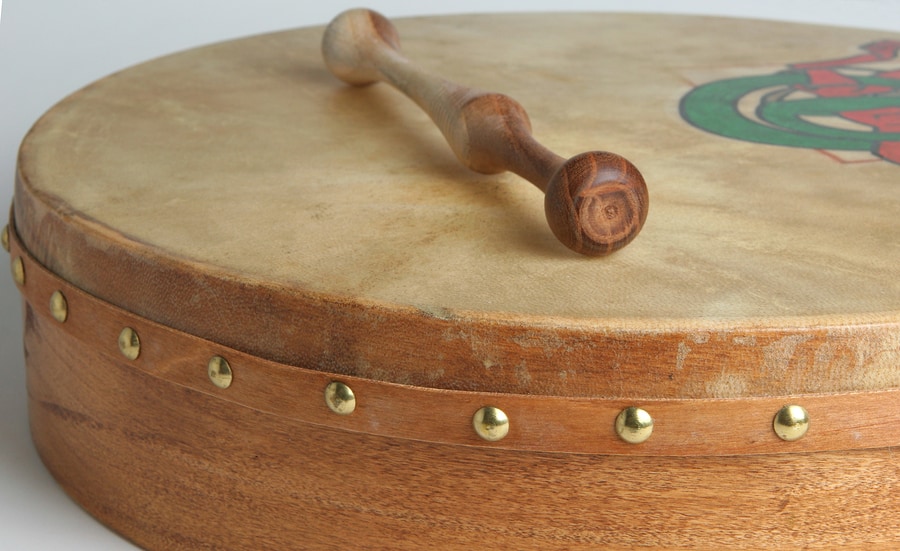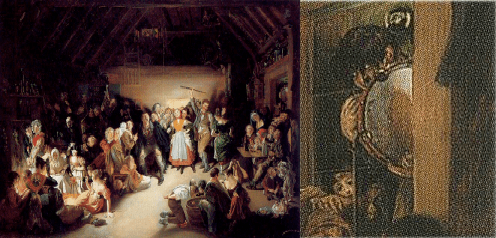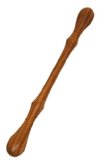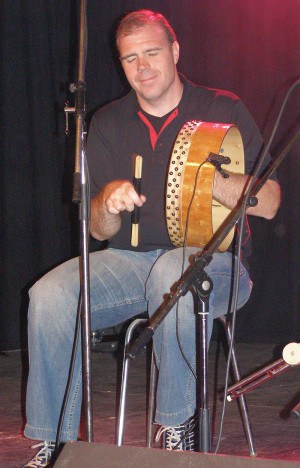
The bodhran (pronounced “bow-rawn”), or simply the Irish drum, is an Irish frame drum measuring 12 to 24 inches in diameter and a depth between 4 to 8 inches. Its body is usually a hard, circular wooden or plastic piece. Normally, people make the bodhran drum using goat skin, however, modern bodhrans have been made using other animal skins as well as synthetic materials with similar qualities. The skin is tacked to one side with the other side left bare and open to facilitate control of the pitch during play, which is done by placing your hand against the inner part of the Irish drum.
Occasionally, the frames may be fitted with a crossbar or two to aid in tuning. Bodhrans that have been professionally crafted are fitted with integrated tuning so that the player uses a hex key to either tighten or loosen the skin. The art of tightening or loosening the skin depends greatly on the weather conditions. When buying a bodhran, it is important to learn the difference between tacked bodhrans and tunable bodhrans.
At first glance, the Irish frame drum might seem like an easy musical instrument to play, but that is not always the case. It uses the coordination of both the lower and upper body depending on the style being played. In order to play the Irish drum, the drum must be held on the thigh and supported by the arm and the upper body at the same time. One hand must be placed under the skin to tighten or loosen it by pushing to provide the required pitch and timbre. The varied tension of the skin, coupled with the strike of the tipper, produces the tunes.
Table of Contents
History of the Bodhran

There is also an ancient canvas painting by Dan Maclise who lived between 1806 and 1870 that clearly shows the Irish drum being played at a Halloween party. Interestingly, it appears they were played by use of bare fingers as opposed to tippers as is the case with the modern Irish frame drum.
Meaning of “Bodhran”
The name “bodhran” is an Irish word that derives from the word bodhar which means deaf or dull.[3] Others insist the word means skin tray due to its likely origin within agriculture.[4] Either way, this tambourine replacement has grown in popularity within Irish traditional music since the 1960’s as well as other nearby countries. In Scotland for example, Celtic music has gained a considerable amount of popularity with the bodhran drum labeled as one of the staples of its music. Southern England also has an instrument by the name of the “riddle drum” (sometimes called the crowdy-crawn) which bears a striking similarity to the Irish drum equivalent and has become increasingly popular in their music.
Modifications to the Irish Drum
Nowadays, most bodhrans will have insulated edges to reduce unnecessary tones brought about by vibrations of the skin. The most common material used for insulating is electric tape because it’s made of rubber and is easy to stretch. Modern bodhrans have also been fitted with screws to aid in adjusting the skin tension to required levels. Players by now know that atmospheric conditions may influence loosening or tightening of the skin and, therefore, will use these screws to make necessary adjustments to the Irish drum.
Bodhran Tippers

The Irish drum is most often played with a small piece of wood known as a tipper. According to history, tippers were initially crafted from bones. Today, however, there are various types of bodhran tippers made mainly from wood. Bare knuckles can also be used to play this instrument, but it is no longer as common as it used to be. The type of tippers used may determine the style, with the double-headed tipper being ideal for the famous Kerry style, and the single-headed tipper performing the West Limerick style. These styles were named according to the place of their origin.
Newer Playing Styles
With the evolution of bodhran music, more and more playing techniques and styles have been born thanks to players like Tommy Hayes and Abe Doron, among others. This newer style of playing is usually done on a smaller, but deeper drum that uses a thinner skin and a straight tipper with the main focus on the top of the drum. Sophisticated techniques that prompt players to follow tunes being orchestrated have been developed, resulting in what has been deemed by many as the rebirth of bodhran music. These techniques have not only received accolades in Ireland but also the world over with rookies receiving music lessons taught using these newer techniques rather than the former techniques.
Listen to Some Funky Bodhran Music!
Watch Josselin Fournel of the band DOOLIN’ break it down with this funky Irish drum solo! As you can see by the way Josselin plays, the Irish drum requires exceptionally good hand-eye coordination and rhythm in order to play it effectively. Most professional Irish drum players are the way they are because they spend hours at a time practicing their stroke, so don’t be discouraged if you’re just now thinking of playing one or have been playing one for a little bit. Practice is the key, and good practice habits mixed with dedication can go a long way if you’re wanting to learn how to play the bodhran!
Here are some other fantastic bodhran music videos to tap your feet to:
List of Notable Players

Source: Wikipedia[5]
- Seán Ó Riada – Ireland
- Junior Davey – Ireland
- David Fallon – Ireland
- Mel Mercier – Ireland
- Kevin Crawford – England
- Albert Alfonso – USA
- Christy Moore – Ireland
- Gino Lupari – Ireland
- Jesse Winch – Scotland
- Rob Bitter – Holland
- Caroline Corr – Ireland
- Mance Grady – Ireland
- Ken Larson – Ireland
- Rick Jones – Ireland
- Mark Hellenberg – Ireland
- Joan DiBlasi – Ireland
- Myron Bretholz – Ireland
- Jim Higgins – Scotland
- Martin O’Neill – Scotland
References
- “Snap-Apple Night globalphilosophy” by Daniel Maclise – 1833 painting by Daniel Maclise. Via http://en.wikipedia.org/wiki/File:Maclise.snap.apple.night.jpg. Licensed under Public Domain via Wikimedia Commons.
- Nolan, R. (2003). History of the Irish Drum. Irish Music.
- Mittleman, J. (1999, March 30). Linguistics of Bodhrán-related Words. Retrieved December 14, 2015, from http://www.ceolas.org/instruments/bodhran/linguistics.shtml
- “bodhrán,” Grinnell College Musical Instrument Collection, accessed December 14, 2015, https://omeka1.grinnell.edu/MusicalInstruments/items/show/308
- “Kevin Crawford on the bodhrán” by David M. Jensen (Storkk) – Own work. Licensed under CC BY-SA 3.0 via Commons.
- Drum Solo by Josselin Fournel (DOOLIN’) – sept. 2011. (2012, February 23). Retrieved December 14, 2015, from https://www.youtube.com/watch?v=NhpybB6lfcc

Wow what a beautiful instrument! Interesting to know that it was originally made from goat’s skin. I wonder how much more modern materials have change or altered the sound, if any.
Yeah the bodhran is definitely a fantastic instrument. I have yet to purchase one myself, but I want to so I can practice playing it soon!
Very important to know how much to tighten the skin. The sound quality depends on that.
This is a nice information piece about Irish bodhran. I am more familiar with its close cousin tambourine. With the recent revival of traditional Irish music, bodhran , with a goatskin head and played with a tipper, is becoming more popular than tambourine.
I find this article a comprehensive piece about the Irish bodhran. I love drums and although I am more familiar with the djembe and the tabla (my husband has a collection of those at home), I would like to try the bodhran and add it to the pieces we have.
This is a very informative blog about Irish bodhran. I should take note that tacked bodhrans are different from tunable bodhrans if ever I will buy a bodhran.
That is a beautiful instrument! i have always had a passion for all things Celtic, and I am just in love with this! I would love to find one to add to my collection.
I believe I have found the next instrument I wish to learn to play. There is such beauty and tradition behind the bodhran that it makes my heart smile.
What interesting history! This is not a very well known musical instrument. It is good to know more about it.
Such a great history page for the bodhran. I never knew the the name “bodhran” is an Irish word meaning drum. Will share your article in some music forums I frequent. Will revisit soon!
Thank you so much! 🙂
Nice potted history of the bodhrán.
Thanks for sharing this. 🙂
Thank you for the comment! 🙂
Hi, I loved this history on the bodhran. I’m buying my first one in a few days. How do I know how tight to tighten it. Thank you
Hi Linda,
Assuming youre buying a tunable bodhran and not a tacked bodhran (tacked bodhrans arent able to be tuned), it’s up to you how tight you want your bodhran skin to be tuned because it will produce a different sound depending on its tuning. I would just play around with it and see what level of tightness produces the best sound for you & just go from there! 🙂 check out my buyer’s guide too before you buy one: https://celticmusicinstruments.com/bodhran-for-sale/
There are two interesting things about the Maclise painting. The first is that it is the *only* representation that ever gets cited of a bodhran pre mid 20th century. The second is that it is clearly not a modern bodhran but a tambourine.
That’s it, there is nothing else. All the stuff about “wren boys” is irrelevant (what they had was not being used as a musical instrument), and the other theories all beg the question.
Why this need to create a romanticised “back story” for the bodhran? I think it’s based upon two things. One is ignorance ie. that this must be an old instrument. The other is a sense of insecurity by bodhran players trying to justify its place in Irish folk music.
There are many other assumptions too. Because other well known genres of music (pop, rock etc) basically require drums, it is believed that it must have been a fundamental in Irish folk music too. Also must be the assumption that the modern styles of ensemble (band) and session playing are the way that the music has always been played.
Neither of these assumptions are true either.
So, the bodhran. It’s a modern innovation in Irish music (mid twentieth century) that has been developing quite fast both is playing style and in the drums themselves, and to my mind is still finding its feet in the tradition. Does this mean it is some sort of alien interloper that should be rejected? No. I think not. It should, though, be treated with circumspection.
What do I mean by this?
Dance tunes in Irish traditional music are complete in themselves. A single fiddle player will provide everything that a dancer needs in terms of rhythm, lift and phrasing. Nothing more is needed. This is something that Irish folk music shares in common with its close companions; English, Scottish and Welsh folk music.
You do not find a “groove” that the tune then floats over. The rythms, both in the time signature and the other internal rhythms, syncopations etc are all found and developed by the melody instrument player. These rythms all come from the tune. It is a *melody* driven tradition, not a harmonic or percussion driven one.
When a bodhran player understands this, and “plays the tune”. When they develop the rythms and structures of the tune, then to my mind, they can fit in as well as any other instrument. In the end, it is the player and not the instrument that defines the tradition and there are many other new or what are seen as innovative instruments that have come into traditional music very successfully.
Playing with a bodhran player can be a delight. As much as playing with any other good musician. The problem I think comes from the assumption (more of those damned assumptions) that is it an easy instrument and you really don’t have to do much to learn. I well remember once seeing a stack of bodhrans by a musical stall (at Warwick Folk Festival) with a sign saying “buy a bodhran and join in a session today!”.
The reality is of course, that any instrumentalist needs to learn their instrument and crucially, the idiom. This is as much true for the bodhran as for any other instrument.
Only one American bodhran player mentioned? What about Ian Walsh or Mark Stone?